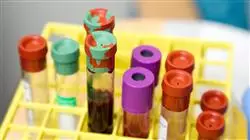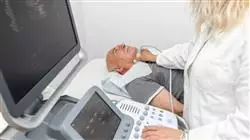University certificate
The world's largest faculty of medicine”
Why study at TECH?
This Advanced master’s degree will allow you to learn about the latest advances in endocrinology, delving into subjects such as thyrotropinomas or radionuclide therapy in pheochromocytomas"

Recent advances in endocrinology and endocrine oncology have improved the diagnostic processes, follow-up and treatment of patients with hormonal and metabolic problems. Thus, at present specialists can incorporate these new developments into their practice, but to do so they need access to a program that is adapted to their needs and professional circumstances.
This Advanced master’s degree in Clinical Endocrinology will completely suit the physician, as its 100% online teaching methodology has been specifically designed with practicing specialists in mind. This way, you can decide when, where and how to study, without being subjected to uncomfortable commutes or rigid schedules. In addition, you will have at your disposal a prestigious faculty team that will update you with a wide range of multimedia resources: video procedures, analysis of actual clinical cases, master lectures or interactive summaries, among others.
Thus, thanks to this teaching system, endocrinologists will be able to delve into relevant aspects of the discipline such as the physiology of the menstrual cycle, the molecular aspects of differentiated thyroid carcinoma, the causes of nodular thyroid disease or hereditary disorders of carbohydrate metabolism.
Incorporate into your daily work the most up-to-date developments in oncology of the endocrine system thanks to this Advanced master’s degree, which is designed using the best multimedia resources"
This Advanced master’s degree in Clinical Endocrinology contains the most complete and up-to-date scientific program on the market. Its most notable features are
- Case studies presented by experts in endocrinology
- The graphic, schematic, and practical contents with which they are created, provide scientific and practical information on the disciplines that are essential for professional practice
- Practical exercises where self-assessment can be used to improve learning
- Special emphasis on innovative methodologies in the field of Endocrinology
- Theoretical lessons, questions to the expert, debate forums on controversial topics, and individual reflection assignments
- Content that is accessible from any fixed or portable device with an Internet connection
Update yourself in a fast and convenient way thanks to this program, specially designed to bring professionals closer to the latest scientific evidence in this medical field"
The teaching staff includes medical professionals who bring their experience to this training program, as well as renowned specialists from leading societies and prestigious universities.
The multimedia content, developed with the latest educational technology, will provide the professional with situated and contextual learning, i.e., a simulated environment that will provide an immersive training experience designed to train for real-life situations.
This program is designed around Problem Based Learning, whereby the student must try to solve the different professional practice situations that arise during the academic year. For this purpose, the professional will be assisted by an innovative interactive video system created by renowned and experienced experts.
TECH online learning system will allow you to choose the time and place to study, without interfering with your work"

You will be accompanied by a highly prestigious faculty team in the field of endocrinology to assist you throughout your learning process"
Syllabus
This Advanced master’s degree in Clinical Endocrinology is composed of 20 specialized modules, and will allow the specialists to delve into issues relevant to this field such as the clinical manifestations and diagnosis of metabolic syndrome, polycystic ovary syndrome and chronic anovulation, gastrointestinal hormones in the control of dietary intake or the indications for the treatment of hyperparathyroidism in patients with MEN 2, among others.

TECH has assembled the most comprehensive and advanced knowledge in this program, which has been developed into 20 specialized modules"
Module 1. Hypothalamus, Pituitary Gland and Autoimmune Pathology
1.1. Endocrinology
1.1.1. Types of Hormones
1.1.2. Synthesis, Processing and Degradation of Hormones
1.1.3. Hormone Receptors
1.1.4. Regulating Systems
1.1.5. Endocrine Autoimmunity
1.1.6. Genetic Basis of Endocrine Diseases
1.2. Endocrine Pathophysiology
1.2.1. Biosynthesis Disorders
1.2.2. Secretion Disorders
1.2.3. Transportation Disorders
1.2.4. Action Disorders
1.2.5. Regulatory Disorders
1.2.6. Autonomous Hormone Production
1.3. Metabolism, Hormones and Coenzymes
1.3.1. Nutrients
1.3.2. Glucose Pathways
1.3.3. Lipids
1.3.4. Proteins
1.3.5. Energy Production and Use
1.3.6. Specific Metabolic Particularities
1.4. Hypothalamic and Pituitary Physiology
1.5. Hypopituitarism
1.6. Pineal Gland Pathology
1.7. Pituitary Tumor Syndromes
1.8. Inadequate ADH Secretion
1.9. Central Diabetes Insipidus
1.10. Autoimmune Polyglandular Syndromes
1.10.1. Autoimmune Polyglandular Autoimmune Syndrome Type 1
1.10.2. Autoimmune Polyglandular Autoimmune Syndrome Type 2
Module 2. Thyroid Gland, Parathyroid Gland and MEN
2.1. Physiology and Thyroid Function Tests
2.2. Goiter and the Euthyroid Patient Syndrome
2.3. Hypothyroidism
2.4. Hyperthyroidism
2.5. Thyroiditis
2.6. Thyroid Nodule and Thyroid Cancer
2.7. Biology of Mineral Metabolism
2.7.1 Parathyroid Hormone
2.7.2. Vitamin D
2.7.3. Regulation of Mineral Metabolism
2.7.4. Laboratory Evaluation of Mineral Metabolism
2.8. Hypoparathyroidism and Pseudohypoparathyroidism
2.9. Hyperparathyroidism
2.9.1. Primary
2.9.2. Secondary
2.10. Multiple Endocrine Neoplasms
2.10.1. Type 1 MEN
2.10.2. Type 2 MEN
Module 3. Disorders of the Adrenal Glands
3.1 Anatomy
3.2. Physiology of the Adrenal Glands
3.3. Cushing's Syndrome
3.4. Adrenal Insufficiency
3.5. Hyperaldosteronism
3.6. Hypoaldosteronism
3.7. Pheochromocytoma
3.8. Congenital Adrenal Hyperplasia
3.9. Incidentalomas
3.10. Tumors and Adrenal Metastases
Module 4. Obesity, Metabolic Syndrome and Dyslipidemia
4.1. Epidemiology and Measurement of Obesity
4.2. Adipocyte, Etiology and Consequences of Obesity
4.3. Epidemiology and Etiology of the Metabolic Syndrome
4.4. Pathophysiology of the Metabolic Syndrome
4.5. Clinical Manifestations and Diagnosis of the Metabolic Syndrome
4.5.1. Relationship of the Metabolic Syndrome with HTA
4.5.2. Relationship between the Metabolic Syndrome and Heart Failure
4.6. Prevention and Treatment of the Metabolic Syndrome
4.6.1. Importance of Lifestyle
4.6.2. Vasculoprotective and Etiopathogenic Treatment
4.7. Lipoprotein Metabolism and Classification of Dyslipidemias
4.8. Lipid-lowering Drugs and Therapeutic Strategies
4.9. Dyslipidemia Management in Different Clinical Situations
4.9.1. Familial Dyslipidemia
4.9.2. Women
4.9.3. Elderly people
4.9.4. Diabetes and the Metabolic Syndrome
4.9.5. Secondary Prevention
4.10. Non-pharmacological Methods
4.10.1. Lifestyle
4.10.2. Functional Foods
4.10.3. Medicinal Plants
Module 5. Diabetes Mellitus
5.1. Etiology, Classification and Prevalence
5.2. Etipathogenesis, Insulin Resistance and Metabolic and Molecular Pathogenesis
5.3. Diabetes Mellitus Type 1
5.4. Genetic Basis of Type 2 Diabetes Mellitus
5.5. Microvascular Complications
5.5.1. Pathogenesis
5.5.2. Diabetic Retinopathy
5.5.3. Diabetic Nephropathy
5.5.4. Diabetic Neuropathy
5.6. Macrovascular Complications
5.6.1. Ischemic Heart Disease
5.6.2. Diabetic Cardiomyopathy
5.6.3. Heart Failure
5.6.4. Stroke
5.6.5. Peripheral Arterial Disease
5.7. Oral Antidiabetics
5.8. Insulin Therapy
5.9. Special Considerations
5.9.1. Lipodystrophic Diabetes Mellitus
5.9.2. Total Parenteral Nutrition
5.9.3. Glucocorticoids
5.10. Diabetes and Public Health
5.10.1. Screening Diabetes Mellitus Type 2
5.10.2. Prevention of Type 2 Diabetes Mellitus
Module 6. Endocrinological Emergencies
6.1. Thyrotoxic Crisis
6.2. Myxedematous Coma
6.3. Non-ketotic Hyperglycemic Hyperosmolar Crisis
6.4. Diabetic Ketoacidosis
6.5. Acute Adrenal Insufficiency
6.6. Hypoglycemia
6.7. Pituitary Apoplexy
6.8. Hypocalcemia
6.9. Hypercalcemia
6.10. Pediatric Endocrinologic Emergencies
Module 7. Disorders of Intermediate Metabolism and Bone Metabolism
7.1. Hemochromatosis
7.2. Wilson's disease
7.3. Porphyrias
7.4. Disorders of Purine and Pyrimidine Metabolism
7.5. Lysosomal Storage Diseases
7.5.1. Pathogenesis
7.5.2. Tay-Sachs Disease
7.5.3. Fabry’s Disease
7.5.4. Gaucher’s Disease
7.5.5. Niemann-Pick’s Disease
7.5.6. Mucopolysaccharidosis
7.5.7. Pompe’s Disease
7.5.8. Lysosomal Acid Lipase Deficiency
7.6. Inherited Carbohydrate Metabolism Disorders
7.6.1. Glycogenosis
7.6.2. Galactose Metabolism Alterations
7.6.3. Fructose Metabolism Alterations
7.7. Hereditary Membrane Transport Disorders
7.7.1. Cistinuria
7.7.2. Lisinuria
7.7.3. Citrulinemia
7.7.4. Hartnup's Disease
7.7.5. Cystinosis
7.8. Osteomalacia, Rickets and Osteogenesis Imperfecta
7.8.1. Bone Remodeling
7.8.2. Osteomalacia
7.8.3. Rickets
7.8.4. Osteogenesis Imperfecta
7.9. Osteoporosis
7.9.1. Epidemiology
7.9.2. Pathophysiology
7.9.3. Diagnosis
7.9.4. Treatment
7.9.5. Osteoporosis Secondary to Glucocorticoids
7.10. Paget's Disease and Other Bone Dysplasias
7.10.1. Paget's Osteopathy
7.10.2. Sclerosing Bone Disorders
7.10.3. Defective Mineralization
7.10.4. Fibrous Dysplasia
7.10.5. Sd. McCune-Albright
Module 8. Clinical Nutrition and Dietetics
8.1. General Principles
8.1.1. Assessment of Nutritional Status
8.1.2. Nutritional Requirements
8.1.3. Food Categories
8.1.4. Malnutrition Markers
8.2. Dietetics and Dietetic Therapy
8.2.1. Dietary Recommendations
8.2.2. Characteristics of the Different Types of Diets
8.2.3. Nutritional Requirements
8.3. Enteral Nutrition
8.3.1. Methods and Mechanisms of Dosage
8.3.2. Indications, Contraindications and Complications
8.4. Parenteral Nutrition
8.4.1. Types
8.4.2. Routes and Mechanisms of Dosage
8.4.3. Indications, Contraindications and Complications
8.4.4. Nutrients in Parenteral Nutrition
8.4.5. Preparation of Mixtures for Parenteral Nutrition
8.5. Dietary and Pharmacological Treatment of Obesity
8.5.1. Pre-treatment Assessment
8.5.2. Modifications in Caloric Content
8.5.3. Modification of Dietary Macronutrients
8.5.4. Specific Role in the Control of Obesity
8.5.5. Pharmacological Treatment of Obesity
8.6. Diabetes Mellitus
8.6.1. Objectives
8.6.2. Types of Diet
8.6.3. Strategies in Nutrition
8.6.4. Recommended Caloric Intakes
8.6.5. Macronutrient Distribution
8.6.6. Other Nutrients
8.7. Nutritional Aspects of Hyperlipemia
8.7.1. Influence of Fatty Acids on Cardiovascular Risk
8.7.2. Effects of Sterols on Cardiovascular Risk
8.7.3. Recommendations to Reduce the Impact of an Atherogenic Diet
8.7.4. Other Nutritional Recommendations
8.8. Hydrosaline Metabolism
8.8.1. Sodium Controlled Diet
8.8.2. Potassium Controlled Diet
8.8.3. Diet in Arterial Hypertension
8.9. Nutrition in Gastrointestinal Pathologies
8.9.1. Diet in Celiac Disease
8.9.2. Diet and Hepatobiliary Disease
8.9.3. Diet and Inflammatory Bowel Disease
8.9.4. Lactose Intolerance
8.9.5. Probiotics, Prebiotics, Symbiotics and Fiber
8.10. Nutrition and Renal Pathology
8.10.1. Malnutrition as a Morbimortality Factor
8.10.2. Nutritional Assessment in the Renal Patient
8.10.3. Nutritional Recommendations
8.10.4. Nutritional Treatment
Module 9. Women and endocrinology
9.1. Physiology of the Menstrual Cycle
9.2. Amenorrhea
9.2.1. Classification
9.2.2. Primary Amenorrhea
9.2.3. Secondary Amenorrhea
9.3. Polycystic Ovary Syndrome and Chronic Anovulation
9.4. Hyperandrogenism and Hirsutism
9.5. Hyperprolactinemia
9.6. Gestational Diabetes
9.7. Endocrinology of Pregnancy
9.7.1. Pituitary Hormones
9.7.2. Thyroid hormones
9.7.3. Sex Hormones
9.7.4. Placental Hormones
9.8. Hormonal Contraception
9.9. Hormones and Reproduction
9.10. Climacteric
9.10.1. Hormonal Changes
9.10.2. Clinical Manifestations
9.10.2.1. Vasomotor Symptoms
9.10.2.2. Menstrual Alterations
9.10.2.3. Psychological Sphere
9.10.3. Osteoporosis and Menopause
9.10.4. Cardiovascular Disease and Menopause
9.10.5. Hormone Replacement Therapy
Module 10. Miscellaneous
10.1. Gonadal Pathology
10.1.1. Male Hypogonadism
10.1.2. Male Hypergonadism
10.2. Endocrinologic Diseases in the Elderly
10.2.1. Endocrinological Changes in Aging
10.2.2. Endocrinopathies in the Elderly
10.2.3. Diabetes Mellitus in Older Adults
10.2.4. Thyroid Diseases in the Elderly
10.3. Endocrine Neoplasms of the Pancreas
10.4. Carcinoid Syndrome
10.5. Paraneoplastic Endocrinopathies
10.6. Arterial Hypertension of Endocrine Origin
10.7. Gastrointestinal Hormones in the Control of Dietary Intake
10.7.1. Anorexigenic Hormones
10.7.2. Orexigenic Hormones
10.8. Central Nervous System and Hormones
10.8.1. Thyroid Hormones
10.8.2. Steroids
10.8.3. Testosterone
10.9. Short Stature: Diagnostic Approach and Therapeutic Basis
10.10. Endocrine System and Heart
10.10.1. Pituitary and Cardiovascular System
10.10.2. Cushing's Syndrome and Cardiovascular Disease
10.10.3. Thyroid and Cardiovascular System
10.10.4. Parathyrin and Cardiovascular System
10.10.5. Adrenal Gland and Cardiovascular System
Module 11. Hypothalamic-Pituitary Tumor Pathology
11.1. Pathogenesis of Pituitary Tumors
11.2. Clinical and Prognostic Classification of Sellar Tumors: List Clinical, Radiologic, Functional and Anatomic Pathology Elements to Characterize the Prognosis of Sellar Lesions.
11.2.1. Adenomas
11.2.1.1. Clinical, Functional and Radiological Classification
11.2.1.2. Pathologic Anatomy of Pituitary Adenomas
11.2.2. Non-adenomatous Sellar Tumors: Rathke's Pouch (Cysts, Craniopharyngiomas), Meningiomas
11.2.3. Non-proliferative Lesions: Inflammatory, Hemorrhagic
11.3. Imaging Study of Hypothalamic-Pituitary Tumor Pathology
11.4. Ophthalmologic Assessment of Hypothalamic-Pituitary Tumor Pathology
11.5. Prolactinoma Differential Diagnosis of Hyperprolactinemia
11.6. Acromegaly
11.7. ACTH-dependent Cushing's Syndrome Cushing's Disease
11.8. Non-functioning Pituitary Adenomas and Gonadotropinomas
11.9. Less Common Pituitary Adenomas
11.9.1. Thyrotropinomas. Multi-hormonal Adenomas
11.9.2. Aggressive Pituitary Adenomas
11.10. Other Lumps of the Sellar Region
11.10.1. Rathke's Pouch Cyst and Craniopharyngioma
11.10.2. Meningioma Pituicytoma
11.11. Surgical Treatment of Sellar and Parasellar Lesions
11.11.1. Surgical Treatment
11.11.2. Postoperative Hypothalamic-Pituitary Functional Evaluation
11.12. Radiotherapy and Radionuclide Therapy for Sellar and Parasellar Lesions
11.12.1. Radiotherapy
11.12.2. Radionuclide Therapy
11.12.3. Long-term Monitoring after Radiotherapy
11.13. Importance of the Tumor Committee and Patient Associations
11.13.1. Multidisciplinary Approach
11.13.2. Role of Patients' Associations Association of Patients Affected by Acromegaly
Module 12. Thyroid Nodule Management. Parathyroid Tumors
12.1. Causes of Nodular Thyroid Disease Thyroid Incidentaloma
12.2. Assessment of Nodular Thyroid Disease Data that Should Lead us to Suspect Malignancy
12.2.1. Clinical Data, Personal and Family History
12.2.2. Scanning Data Laboratory Data
12.3. Ultrasound in the Assessment of Nodular Thyroid Disease
12.3.1. Cervical Ultrasonography
12.3.2. TIRADS Classification. ATA Classification
12.4. Thyroid Scan Other Imaging Techniques
12.5. Cytological Study of Nodular Thyroid Disease
12.5.1. Fine Needle Aspiration Puncture (FNA) with Ultrasound Monitoring
12.5.2. Bethesda Classification
12.6. Hyperthyroidism Caused by a Hyperfunctioning Thyroid Nodule Hyperfunctioning Multi-nodular Goiter Treatment
12.7. Usefulness of Molecular Markers What to do with Bethesda III?
12.8. Surgical Treatment of Nodular Thyroid Disease
12.8.1. Indications
12.8.2. Types of Treatment
12.9. Other treatments
12.9.1. Ethanolization
12.9.2. Laser Thermal Ablation
12.9.3. Radiofrequency Thermal Ablation
12.10. Approach to Primary Hyperparathyroidism
12.10.1. Classification
12.10.2. Biochemical Diagnosis
12.10.3. Imaging Tests
12.10.4. Treatment
Module 13. Differentiated Thyroid Carcinoma (DTC)
13.1. Molecular Aspects of Differentiated Thyroid Carcinoma Clinical Implications
13.2. Pathologic Anatomy of Thyroid Carcinoma Classification
13.3. Follicular Neoplasia with Papillary-like Changes (FNFTP)
13.4. Papillary Microcarcinoma
13.4.1. Is it Possible to Perform Surveillance Only?
13.4.2. When to Treat?
13.4.3. How to Treat?
13.5. Initial Staging 8th Classification Differences with the 7th Classification
13.6. Surgical Treatment
13.6.1. Initial Surgical Treatment
13.6.2. Treatment of Relapse
13.7. Radioiodine Treatment
13.7.1. When to Treat?
13.7.2. Treatment Dosage
13.7.3. Refractoriness to Radioiodine
13.8. Monitoring Dynamic Risk Staging
13.9. Treatment of Advanced Unresectable DTC
13.10. Importance of the Tumor Committee and Patient Associations
13.10.1. Multidisciplinary Approach
13.10.2. Role of Patients’ Associations AECAT
Module 14. Medullary Thyroid Carcinoma Other Thyroid Carcinomas
14.1. Medullary Thyroid Carcinoma (MTC)
14.1.1. Introduction. Epidemiology
14.1.2. Classification. Anatomopathological Characteristics
14.1.3. Clinical manifestations
14.1.4. Genetic Study
14.2. MTC: Initial Staging Dynamic Risk Staging
14.3. Diagnosis of MTC
14.3.1. Laboratory Tests
14.3.2. Imaging Tests
14.3.3. FNA with Ultrasound Control
14.4. MTC. Surgical Management
14.4.1. Extent of the Surgery
14.4.2. Surgical Treatment of Recurrence
14.4.3. Surgical Treatment of Metastases
14.5. MTC. Radiotherapy Radionuclide Treatment
14.6. MTC. Treatment of an Advanced Unresectable Disease
14.6.1. Tyrosine Kinase Inhibitors
14.6.2. Other Treatments
14.7. CMT. Follow up Prognosis
14.8. Poorly Differentiated Thyroid Carcinoma Anaplastic Carcinoma
14.9. Thyroid Lymphoma and Other Rare Malignant Thyroid Tumors Metastasis of Other Tumors
Module 15. Tumors of the Adrenal Cortex
15.1. Adrenal Incidentaloma Diagnostic Approximation
15.2. ACTH-independent Cushing's Syndrome Caused by Adrenal Adenoma
15.3. Primary Hyperaldosteronism Crohn's Disease
15.4. Adrenocortical Carcinoma (ACC)
15.4.1. Introduction
15.4.2. Clinical History and Examination
15.5. ACC. Genetic Aspects Laboratory Data Hormone Secretion
15.6. ACC. Imaging Tests Ultrasound. CT, MRI, PET-CT
15.7. ACC. Pathologic Anatomy. Staging. Prognostic Factors
15.8. Surgical Management
15.8.1. Surgical Treatment of the Primary Tumor
15.8.2. Surgery and Other Local Treatments for an Advanced Disease
15.9. Adjuvants Radiotherapy Treatment of Relapse
15.10. Treatment for an Advanced Disease
Module 16. Pheochromocytomas and Paragangliomas
16.1. Introduction
16.1.1. Anatomy Recap
16.1.2. Epidemiology
16.2. Molecular Bases Genotype-Phenotype Correlation
16.3. Clinical Manifestations Forms of Presentation
16.4. Laboratory Data
16.5. Imaging Tests
16.6. Surgical Management
16.6.1. Adrenergic Blockade
16.6.2. Surgery of Pheochromocytomas and Paragangliomas Embolization
16.7. Radionuclide Therapy Radiotherapy
16.8. Treatment for an Advanced Disease
16.9. Prognosis and Monitoring
16.9.1. Monitoring of Carriers for the Various Mutations
16.9.2. Long-Term Monitoring
16.9.3. Prognosis
16.10. Importance of the Tumor Committee and Patient Associations
16.10.1. Multidisciplinary Approach
16.10.2. Role of Patients' Associations
Module 17. Multiple Endocrine Neoplasia Syndromes
17.1. Multiple Endocrine Neoplasia type 1 (MEN1) Genetics
17.1.1. MEN 1 Genetics
17.1.2. When to Conduct a Genetic Study to Rule Out Mutation in the Menin Gene?
17.1.3. Genetic Counseling in MEN 1 Preimplantation Diagnosis
17.2. Clinical Manifestations of the Syndrome MEN 1 Presentation Forms
17.3. Laboratory Tests in the Initial Assessment and Subsequent Follow-Up
17.4. MEN 1. Imaging Tests in the Initial Assessment and Subsequent Follow-Up
17.5. MEN 1. Treatment of Primary Hyperparathyroidism (PHPT) Relapse Management
17.6. MEN 1. Pancreatic Neuroendocrine Tumors Surgical Indications
17.7. Management of Other Tumors
17.7.1. NER of Atypical Locations: Bronchial and Thymic NERs
17.7.2. Screening, Monitoring and Treatment of Other Neoplasms
17.8. Multiple Endocrine Neoplasia Type 2 (MEN 2) MEN2 Genetics
17.8.1. Oncogen RET
17.8.2. Genotype-Phenotype Correlation
17.8.3. Less Common Mutations
17.9. MEN 2. Spinal Cord Carcinoma
17.9.1. Assessment and Monitoring After Learning the Carrier Status
17.9.2. Prophylactic Thyroidectomy
17.10. MEN2. MEN2
17.10.1. Assessment and Monitoring After Learning the Carrier Status
17.10.2. Indications for Treatment of Hyperparathyroidism in Patients with MEN 2
17.10.3. Other Manifestations of MEN2
17.11. MEN2. Other Manifestations of MEN2
17.12. Other Multiple Endocrine Neoplasia Syndromes
Module 18. Gastroenteropancreatic Neuroendocrine Tumors (GEPNET)
18.1. Gastroenteropancreatic Neuroendocrine Tumors
18.1.1. Epidemiology
18.2. Molecular and Cellular Bases
18.3. Pathologic Anatomy/Pathogenesis
18.3.1. Classification Systems
18.4. Lung and Thymus NER
18.5. Gastric NERs
18.6. Intestinal NERs. Appendiceal NER
18.7. Non-functioning Pancreatic NERs
18.8. Gastrinoma
18.9. Insulinoma.
18.10. Gucagonoma Somatostatinoma Vipoma Other Functioning Tumors
Module 19. GEPNET. Anatomical and Functional Diagnosis. Locoregional Disease Treatment
19.1. Carcinoid Syndrome Carcinoid Heart Disease
19.2. Syndromes of Ectopic Secretion of ACTH and Other Hormones
19.3. Diagnosis and Monitoring of GEPNETs Biological Markers
19.3.1. Usefulness in Diagnosis and Monitoring
19.4. Diagnosis and Monitoring of GEPNETs Endoscopy and Echoendoscopy-guided Fine Needle Aspiration Puncture (FNA) in the Diagnosis and Monitoring of GEPNETs
19.5. Diagnosis and Monitoring of GEPNETs Imaging Tests I
19.5.1. Ultrasound, Computerized Tomography, Magnetic Resonance Imaging
19.5.2. Response to Treatment Criteria (RECIST, Choi, others, etc.)
19.6. Diagnosis and Monitoring of GEPNETs. Other Imaging Tests II: Nuclear Medicine in the Diagnosis and Follow-up of GEPNETs
19.7. Surgical Treatment of Lung NERs
19.8. Surgical Treatment of Gastric NERs
19.9. Surgical Treatment of Intestinal NERs
19.10. Surgical Treatment of Pancreatic NERs
19.10.1. Treatment of Incidentally Discovered Non-Functioning Pancreatic NERs: Surgery/Monitoring
19.11. Surgical Treatment of G3 Tumors Surgical Treatment of MINEN
Module 20. Gastroenteropancreatic Neuroendocrine Tumors. Treatment for an Advanced Disease
20.1. Surgical Treatment of an Advanced Disease
20.1.1. Indication for Surgical Treatment of the Primary Tumor
20.1.2. Surgical Treatment of Liver Metastases and Other Metastases
20.2. Locoregional Treatments
20.2.1. Embolization
20.2.2. Radiofrequency
20.2.3. Other Locoregional Treatments
20.3. Biological Treatments: Somatostatin Analogues and Others
20.4. Chemotherapy and Targeted Therapies Role of Immunotherapy
20.5. Teragnosis Radionuclide Treatment
20.6. Treatment Sequencing
20.7. Nutritional Management of the Patient with GEPNET
20.8. Importance of the Tumor Committee and Patient Associations
20.8.1. Multidisciplinary Approach
20.8.2. Role of Patients' Associations NET Spain

There is not a more in-depth and updated program than this one to catch up on the large transformations that endocrinology has undergone in recent years"
Advanced Master's Degree in Clinical Endocrinology
.
Given the undeniable advantages brought about by the latest advances in endocrinology and endocrine oncology, updating the theoretical and practical knowledge of professionals specializing in this area is essential. At TECH Global University we have developed the Advanced Master's Degree in Clinical Endocrinology, a program through which you will have access to the most complete and innovative content for the diagnosis, monitoring and treatment of patients with hormonal, metabolic and autoimmune problems. In this way, you will be prepared to make decisions and take on challenges that will not only help ensure the well-being of the patient, but will make you stand out, boosting the growth of your career.
Get your degree at the largest medical school in the world
.
Through intensive training in the latest medical methods, tools and technologies for the treatment of endocrinological conditions, you will be able to prepare yourself to provide specialized service to your patients. You will broaden your knowledge of the diagnostic, classificatory and pharmacological criteria of these disorders; you will be able to identify the epidemiological, pathogenic, clinical and therapeutic aspects of all types of endocrine diseases, as well as to perform and guide the complementary examinations applicable to them, taking into account the particularities of each patient. Get your degree from the largest medical school and start moving towards your career goals.







